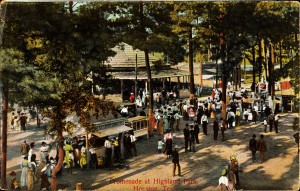By Betty Trapp Chapman

Commerce Street, 1890, the “heart of produce row.” Photo from the George Fuermann “Texas and Houston” Collection, courtesy of Special Collections, University of Houston Libraries
In 1839 Houston was divided into four wards, each a geographic area which provided representation for the municipal government. The crossing at Congress Avenue and Main Street became the intersecting point for dividing the wards. The First Ward, located in the northwest quadrant of that intersection, bordered the strategic location where Buffalo Bayou and White Oak Bayou converged. By design, Main Street ended here, providing a logical docking place for boats for the next six decades. Naturally, the area around the docks fostered a warehouse district where goods were distributed for sale in mercantile establishments in town or for shipment down the bayou. As a result, Commerce Street, the artery closest to the docks, became known as “Produce Row” and a strong factor in the business development of the First Ward.
The First Ward area was also known for its natural resource of free-flowing springs. A number of artesian wells existed near the juncture of White Oak and Little White Oak bayous. In 1832 Thomas D. Beauchamp immigrated to Texas from Kentucky and settled in the bayou area. He reportedly traded with the Bidai Indians and camped with them at the local springs. In 1838 Beauchamp purchased from the Allen brothers a fifty-four-acre tract of land on the south bank of White Oak Bayou that included free flowing springs. There he established a community that he named Beauchampville. Since Buffalo Bayou was the main water supply for Houstonians and its water was frequently contaminated, Beauchamp began selling his pure spring water to Houstonians for seventy-five cents for each thirty-gallon barrel. Not only was it a cleaner water supply for the city, but it enabled Beauchamp to recover some of his investment. Although Beauchampville eventually faded, this area of his property became known as Beauchamp Springs, a location often noted on maps today.
As Houston began to develop, most of the First Ward land outside the town’s business district was laid out in farms. Some of the earliest farmers were German immigrants. Heinrich Guese, a typical German immigrant, bought two acres for fifty dollars in 1857. Guese and his wife, Hannah, built their house, a Gulf Coast cottage, on their property. (The Guese house, constructed on what later became Spring Street, is extant although it was moved to the Sixth Ward a few years ago to escape demolition at its original location.) By 1869 there were fewer than twenty-five houses in the immediate twenty-block area containing the Guese home. Their neighbors were families by the name of Puls, Wichman, Kaertjie, Tiekoetter, and Barteles, many of whom had come from the same town in Germany as the Gueses. These farmers grew produce and sold it at the city’s market, or at independently-run curb markets along Commerce Street. Heinrich Guese reportedly operated two stalls at the Market House and also worked as a gardener.
Because of its proximity to Buffalo Bayou and the Market House, residents in First Ward became heavily involved in the community’s commodity and produce business. Commerce Street was lined with storehouses for goods awaiting transport, first down the bayou and later on the railroads. A portion, however, found its way daily to the First Ward, where European immigrants established grocery stores. By the early twentieth century many of these immigrants were Italian. Names like Valenti, Mandola, Bonno, Costa, Montalbano, and Ciulla appeared on these stores, which were frequently attached to the family’s house. The Bonno family had a wholesale grocery business on Commerce Street where they sold to larger grocery firms in the city. The Bonnos are credited with introducing the sale of coffee in one-pound bags, a practice still in place today.
First Ward represented a typical working-man’s community. Businesses other than grocery stores were boarding houses, saloons, barber shops, bakeries, meat and fish markets, and laundries. The 1866 Houston City Directory listed these occupations for residents: bridge builder, tailor, grocer, blacksmith, gardener, painter, carpenter, machinist, cotton broker, barber, drayman, and railroad engineer. In time, the neighborhood attracted the owners of a brick yard, ice-making plant, iron foundry, and carriage-making firm. In view of the limited means of transportation, people preferred living near their place of business or employment. This made the close-in First Ward residences a popular choice for those engaged in commerce or employed in service-oriented jobs.
To read the entire article, download the pdf version.


 Follow
Follow